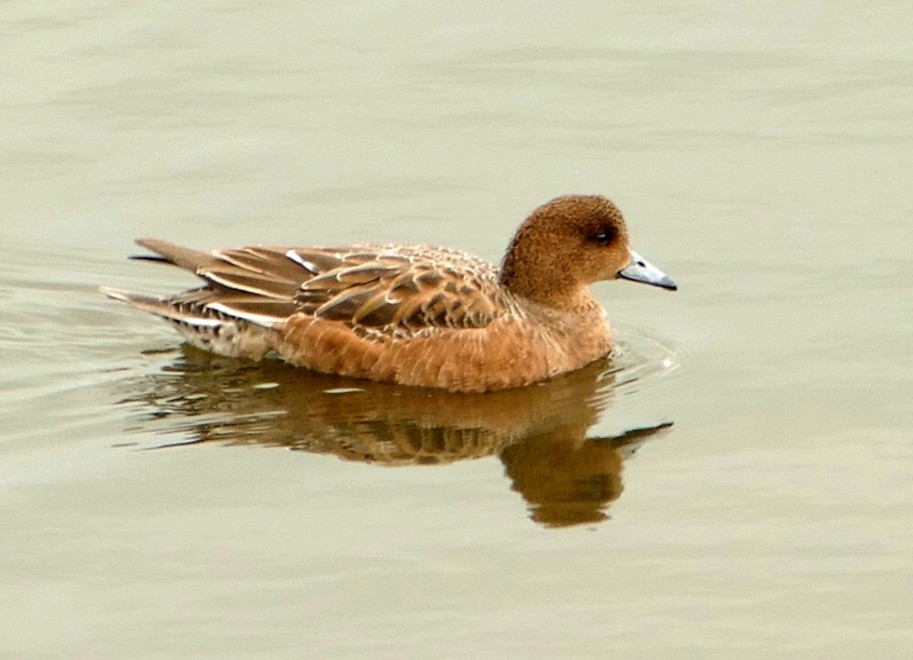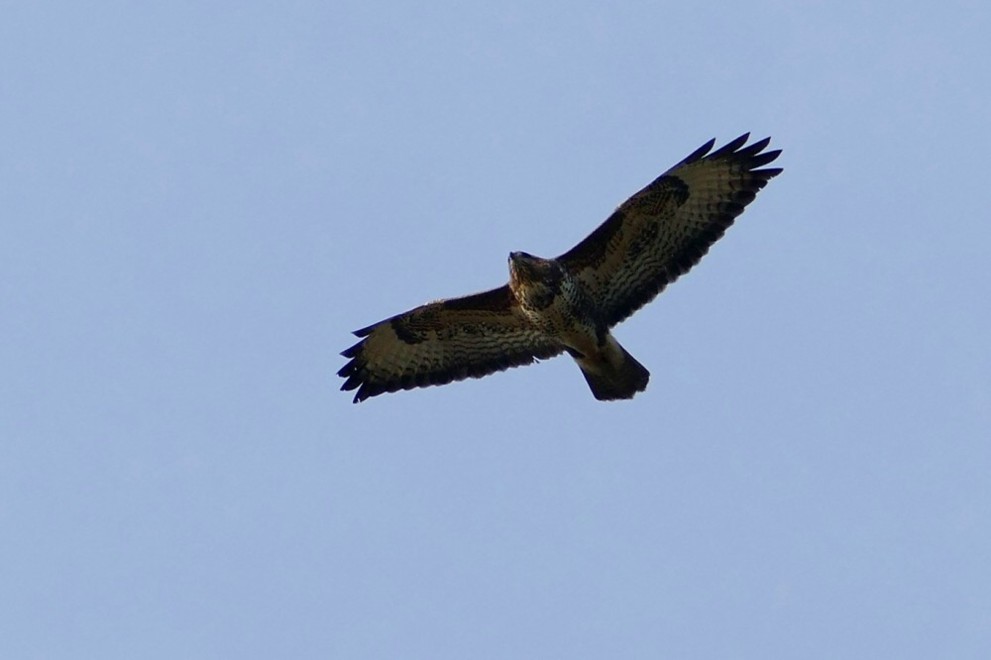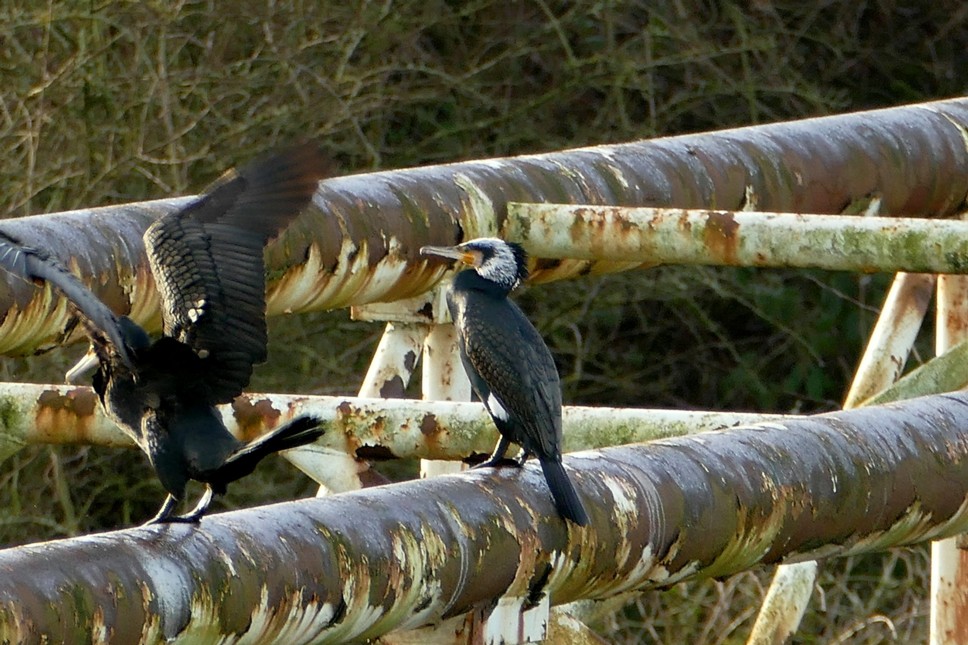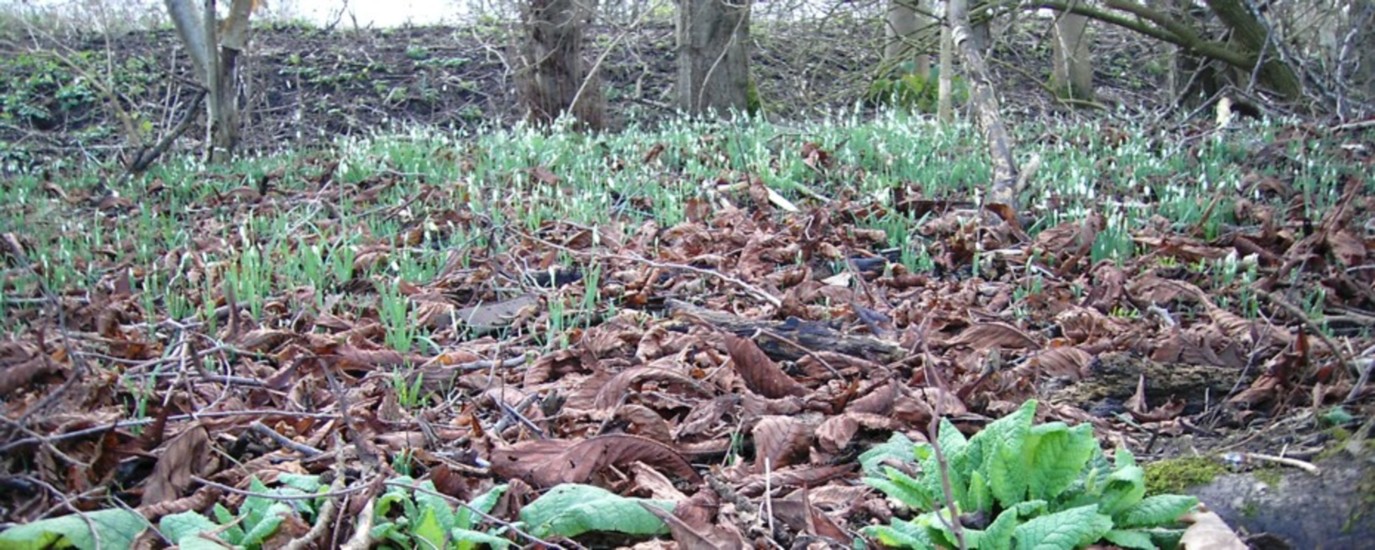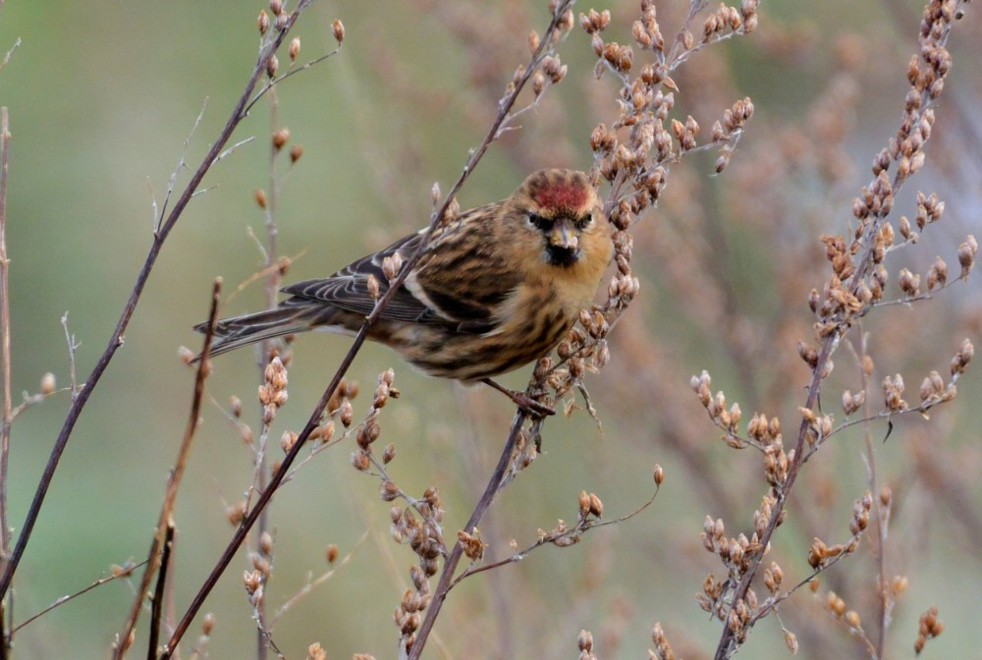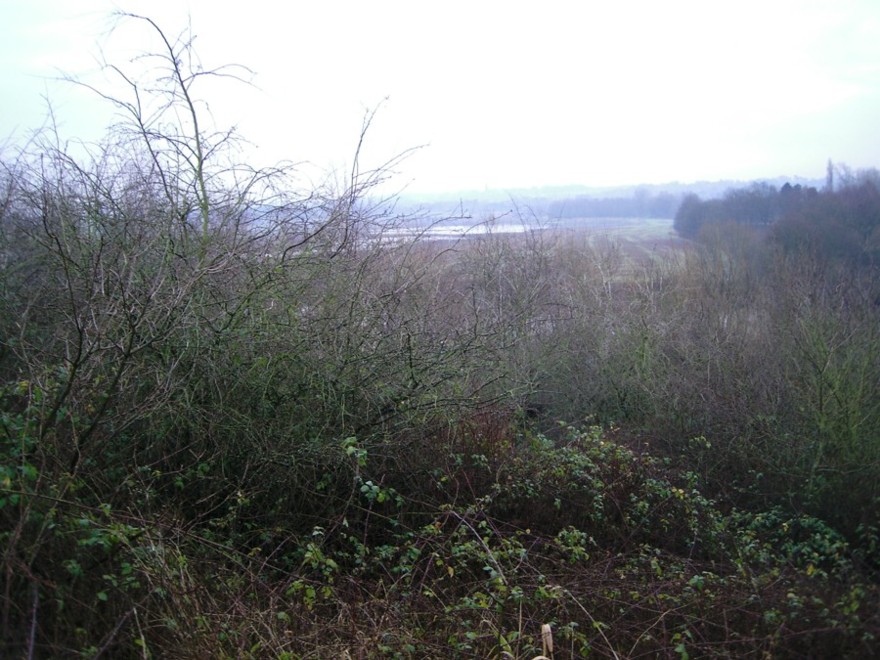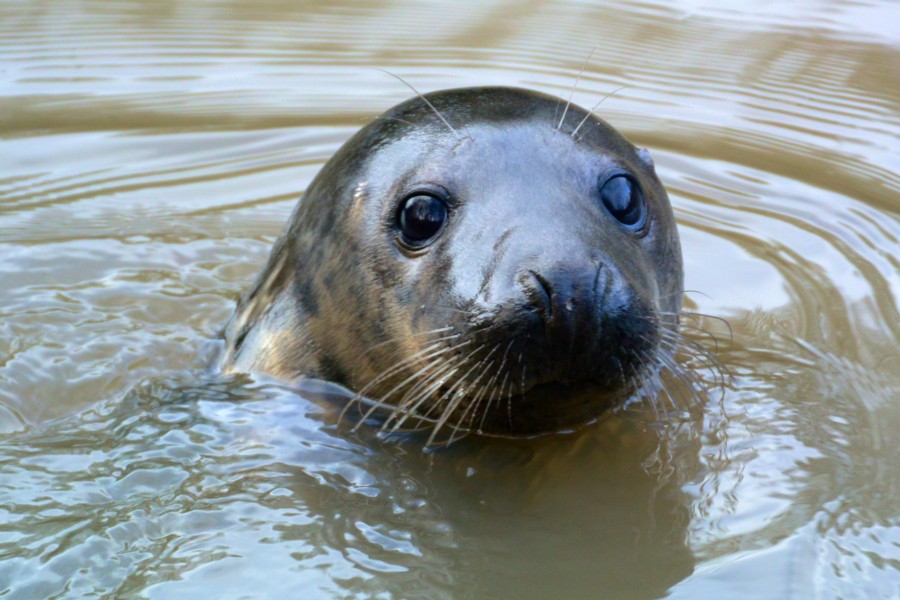Woolston Eyes Monthly Sightings
2016-01-28
Not much change this lunchtime, other than 2 Woodcocks flushed while walking around No.3 bed. The Marsh Tit is still still frequenting the Morgan Hide feeders, along with Willow Tit, while double figure counts of Bramblings and scores of Greenfinches and Chaffinches are regular. Out on the water, most of the Teal remain in cover unless flushed by a passing heron or buzzard, while small numbers of Gadwall, Shoveler, Mallard, Tufted Duck and Pochard, with the odd Wigeon, make up the numbers. With a growing number of Black-headed Gulls dropping in it feels like spring is just around the corner, though the weather could still surprise for us. Back on the Ship Canal by the car park, a search through a flock of 160 Tufted Duck once again failed to turn up a Scaup. Got to keep trying, though
Photo of a distant Wigeon.
Cheers David
Submitted by: David Bowman
2016-01-27
Here’s a link to a video clip of the Truxor reed-cutting machine in action on No.3 bed on Monday.
To view the video copy the link https://www.youtube.com/watch?v=g7lD4NA5wcA into your browser or click on the highlighted link below;
Video of the Truxor reed-cutting machine and finches
Cheers David
Submitted by: David Bowman
2016-01-25
An interesting day on No.3 bed?, where we’d hired a Truxor for two days. It’s basically a reciprocal cutting machine, which can be used on water or in wet reed-beds to cut channels or create pools. The first day went really well and we managed to see some good birds too, with highlights of: 1 Marsh Tit, 2 Willow Tits, 12 Bramblings, 1 Kingfisher, 1 Water Rail, 1 Lesser Redpoll, 3 Siskins, 1 Goldeneye, 120 Greenfinches, 5 Bullfinches and 110 Chaffinches.
Cheers David (with Brian Ankers, David Spencer and John Langley)
Submitted by: David Bowman
2016-01-23
Here’s a photo of a Common Buzzard from Bollin Point this morning.
Cheers David
Submitted by: David Bowman
2016-01-23
Another really enjoyable morning?, with a spring-like feel to the day. We covered No.3 bed and then walked from No.1 bed down to Bollin Point and back. In total we recorded 64 bird species, with highlights of: 1 Jack Snipe, 3 Common Snipe, 2 Willow Tits, 1 Peregrine, 4 Goldeneye, 9 Bramblings, 5 Siskins, 1 Lesser Redpoll, 2 Kingfishers, 2 Sparrowhawks, 1 Kestrel, 3 Buzzards, 238 Tufted Ducks, 1 Water Rail, 405 Lapwings, 3 Reed Buntings, 21 Gadwall, 3 Shelduck, 7 Song Thrushes, 2 Fieldfares, 49 Redwings, 8 Bullfinches, 2 Pied Wagtails, 60 Greenfinches, 110 Chaffinches, 2 Linnets, 3 Skylarks, 2 Meadow Pipits, 28 Goldfinches, 2 Great Crested Grebes, 6 Little Grebes, 42 Pochard and 8 Cormorants (including a nice one of the continental race sinensis in breeding plumage).
A photo of a Cormorant of the continental race sinensis
Cheers David (with Dave Steel?, David Spencer, Alan Warford?, Paul Hazlehurst?, Brian Baird, Helen Allan?, Les Jones and George Dunbar?)
Submitted by: David Bowman
2016-01-22
A fine afternoon proved very fruitful with good duck numbers.
Tufted Duck 338 (214 on No.3 bed,124 at the Weir),Pochard 9(6 males),Gadwall 24,most paired,Shoveler 20, Goldeneye 6 (5 drakes),Mute Swan 4.Shelduck 4.At dusk at least 70 Redwing flew on to west bank of no.3 and hopes were raised when ca.200 Starlings arrived from the south and flew above the reeds near the south bank. Sadly, after a few minutes they departed to the east (no.1 bed?) and did not return.
Submitted by: Brian Martin
2016-01-20
A very pleasant day with sunshine and excellent light during the afternoon. Although there was nothing too unusual there was plenty of interest. On No.1 bed I flushed two Snipe at the eastern end and a Song Thrush was singing on Butchersfield Tip. Three male Goldeneye were at the basin and good numbers of Tufted Duck on the river. A reserve-wide total of 344 was similar to last weekend’s WeBS count. On No.3 bed were 17 Pochard (12 males and 5 females), the highest count of the winter so far. A mixed flock of finches in alders at the Tower Hide included a minimum of 5 Siskins, a Redpoll and a Brambling. Reserve-wide totals included 8 Great-crested Grebes, 3 Little Grebes, 24 Moorhen and 43 Robins. Photo; Snowdrops on No.3 bed
Submitted by: Dave Hackett
2016-01-17
WeBS Count for 16th January.
Little Grebe 2, Great crested Grebe 1,Cormorant 10,Grey Heron 3,Mute Swan 8, Shelduck 4, Greylag Goose 1, Canada Goose 14, Gadwall 37, Teal 634, Mallard 118, Shoveler 39, Tufted Duck 334, Goldeneye 8, Moorhen 10, Coot 35, Water Rail 3, Lapwing 70.
Most of No.3 bed frozen but small area of open water on Loop of No.4 bed. Many of wildfowl on river and Canal.
Submitted by: Brian Martin
2016-01-16
Here’s a photo of one of today’s Lesser Redpolls from No.3 bed.
Cheers David
Submitted by: David Bowman
2016-01-16
With the first hard frost of the year we arrived to find No.3 bed mostly frozen over. As it was Wildfowl Count day we wandered, in crisp, bright sunshine, down to Bollin Point and back. With the wildfowl largely compressed into small areas of open water or on the river and canal, we still managed some decent totals. These included: 400 Teal, 8 Goldeneyes, 37 Shovelers and 280 Tufted Ducks. On the way back from Bollin Point we watched the female Peregrine flying around the Viaduct nest-site and then had a Fox trotting ahead of the car. Finch variety and volume were another feature of the day, with totals of : 30 Bramblings, 20 Siskins, 6 Lesser Redpolls, 21 Bullfinches, 100 Greenfinches and 150 Chaffinches. Finally, finishing back on No.3 bed, we added Marsh Tit, 2 Ravens and a marauding male Peregrine to the day list. Very enjoyable :-) The link to a video clip tries to give a flavour of the morning.
Cut and paste the following link into your browser;
https://www.youtube.com/watch?v=xowCBOfzJyA
or click on the highlighted link below to view the video directly;
“A video of the Flavour of this mornings walk around the Reserve”
Cheers David (with David Spencer, Paul Hazlehurst?. Brian Baird, Helen Allan?, Les Jones and later on, Kelly Ainsworth? and George Dunbar?)
Submitted by: David Bowman
2016-01-12
Spent the afternoon on No.1 bed? and though not much was moving, what there was was of high quality. Near the viaduct the resident pair of Peregrines were very active. They chased a flock of Woodpigeons, with the male making the initial stoop to break up the flock while the female came down like a rocket to turn one of them into a cloud of feathers. Near the feeding station,2 Willow Tits and 2 Lesser Redpolls were with 30 Greenfinches and 40 Chaffinches, while 8 Pheasants were also in attendance. Near the eastern reed-bed a Cetti’s Warbler called several times, as did a Water Rail, while Grey Wagtail and Snipe were also noted. Cheers David
Submitted by: David Bowman
2016-01-08
I was asked, this morning, to give a brief live interview on BBC Radio Merseyside about the Grey Seal at Woolston Eyes. I don’t think David Attenborough’s got anything to be worried about. The link is to the interview on BBC iPlayer and the Woolston bit starts at about 1 hour, 22 mins and 12 seconds in.
Cut and paste the following link into your browser:
http://www.bbc.co.uk/programmes/p03cv5x8#play
or simply click on the highlighted link below and move to 1 hour 22 mins into the broadcast to listen to the 5 minute clip.
BBC Radio interview David Bowman about the Grey Seal at Woolston Eyes
Submitted by: David Bowman
2016-01-07
If you haven’t managed to catch up with the Grey Seal pup which has been frequenting the river below the Hogg Hide - here’s a link to cut and paste into your browser to my Youtube video of it.
https://www.youtube.com/watch?v=LwOMgebATxQ
or click on the highlighted link below to view directly.
Grey Seal pup video at Woolston
Cheers David
Submitted by: David Bowman
2016-01-06
A lovely winter’s day with plenty of sun and excellent light made a pleasant change from the recent rains. A Peregrine was on the viaduct and a skein of Pink-footed Geese (about 150) flew south-east. Dave Riley and John Blundell, who were ringing on No.1 bed at the time, reported three skeins totalling 350 birds. On my return later in the morning a further 200 flew west over the mosslands to the north of the reserve. 32 Mute swans were in the Bollin Point area with an excellent reserve-wide count of 47. On No.3 bed were good numbers of Tufted Duck (a reserve total of 356) and 7 Pochard was, I think, the highest of the winter so far! About 200 Greenfinch were near the feeders with a single Brambling present. Robins seemed to be everywhere and I counted 113 across the reserve, mostly singing males. A sign of approaching spring was 4 singing Song Thrushes. A brief search of the river failed to produce a sighting of the seal which has been reported over the last few days.
Photo; view to the south from Butchersfield Tip showing the recently flooded fields to the east of Lymm Golf Course.
Submitted by: Dave Hackett
2016-01-05
What a fantastic day. Sometimes nature just delivers up a real treat and this was one of those days. I started with the usual bird counts on No.3 bed, with highlights of Green Sandpiper, Woodcock, Brambling and Marsh Tit, plus some excellent wildfowl counts. Then wandered around a bit taking some photos. I then decided to see if I could find the seal which has been around on the Mersey. I ensconced myself quietly on the bank of the river and was then treated to an enchanting hour with this little lost Grey Seal pup. I kept really still but eventually it noticed me and immediately, with typical seal inquisitiveness, came right up to stare at me from six feet away. It then spent the next hour diving and chasing fish and after each sally came over to say hi. At one point I thought it was going to haul out of the river and join me on the bank (I must look a bit like an adult seal). Instead, it snorted, spraying me with river water before going after another fish. When it was time to go, I got up as quietly as I could but it came straight over, came up to the bank, raised itself out of the water and watched me till I’d gone. Remarkable!
Submitted by: David Bowman
2016-01-02
An excellent morning’s birding on No.3 bed, with some good counts and nice variety. Aside from the usual common residents, the pick of the bunch were: 1 Marsh Tit, 25 Bramblings, 1 Water Rail, 1 Kingfisher, 2 Snipe, 1 Peregrine, 3 Sparrowhawks, 2 Buzzards, 2 Wigeon, 1 Siskin, 18 Redwings, 450 Teal, 5 Pochard, 116 Tufted Ducks, 27 Gadwall, 10 Shovelers, 2 Great Crested Grebes, 200 Greenfinches, 100 Chaffinches, 1 Common Gull, 6 Bullfinches, 3 Reed Buntings, 2 Song Thrushes, 221 Lapwings, 1 Grey Wagtail,1 Pied Wagtail, 2 Stock Doves, 8 Jackdaws, 6 Jays, 1 Treecreeper , 2 Shelducks, 16 Herring Gulls, 21 lesser Black-backed Gulls and 625 over-flying Black-headed Gulls.
Cheers David (with Dave Steel, David Spencer, Paul Hazlehurst, Brian Baird, Diane Shepherd and Kelly Ainsworth)
Submitted by: David Bowman

